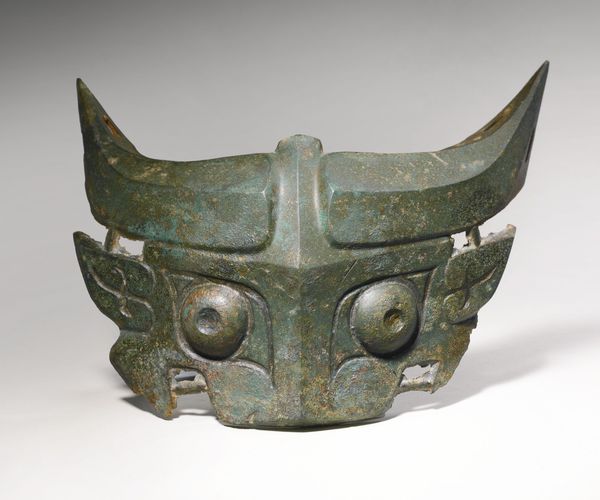A bronze taotie mask, Early Western Zhou dynasty, 11th-10th century BC
A bronze taotie mask, Early Western Zhou dynasty, 11th-10th century BC. Photo: Sothebys.
cast with bulging eyes, flanked by pointed leaf-shaped ears, beneath upcurved bovine horns with hollow tips, the wide upper jaw defined by an out-curved snout and a pair of hooked fangs, with dark green surface patina and widely scattered reddish cuprite encrustation. Width 9 in., 22.9 cm. Estimation 80,000 — 100,000 USD
Provenance: Private Collection, Geneva, since the 1950s.
J.J. Lally & Co., New York, 2011.
Exposition: Ancient Chinese Bronzes, J.J. Lally & Co., New York, Spring 2011, cat. no. 11.
Notes: The function of bronze taotie masks of this type has been discussed by several scholars. Max Loehr proposes that objects of this kind were part of the ritual equipment of a shaman wearing a mask at performances. However, recent scholarship suggests that this type of taotie mask was used as a decorative frontlet mounted on the forehead of a chariot horse possibly to demonstrate the magical power of the rider.
The present mask is unusual in its casting technique. In order to render hollow space on two tips of the horns, the tips were cast separately from the main part of the mask, which entailed the skillful use of multiple clay piece moulds.
An almost identical bronze taotie mask in the collection of the Honolulu Academy of Arts is illustrated in Ancient Chinese Bronzes, Ceramics and Jade in the Collection of the Honolulu Academy of Arts, Honolulu, 1979, p. 95, no. 36; a bronze taotie mask of this type with scale-covered horns excavated in 2011 from an Western Zhou tomb site in Suizhou city, Hubei province, is discussed and illustrated in the ‘Hubei Suizhou Yejiashan M65 fajue jianbao’ (Preliminary excavation report of the tomb no. 65 at Yejiashan), Jianghan Kaogu, 2011, 3, p. 30, pl. 22.
Sotheby's. Magnificent Ritual Bronzes – Property from the Collection of Julius Eberhardt. New York | 17 sept. 2013 - http://www.sothebys.com

/https%3A%2F%2Fprofilepics.canalblog.com%2Fprofilepics%2F1%2F0%2F100183.jpg)
/https%3A%2F%2Fstorage.canalblog.com%2F03%2F02%2F119589%2F96711876_o.jpg)
/https%3A%2F%2Fstorage.canalblog.com%2F11%2F31%2F119589%2F94773502_o.jpg)
/https%3A%2F%2Fstorage.canalblog.com%2F20%2F83%2F119589%2F94772815_o.jpg)
/https%3A%2F%2Fstorage.canalblog.com%2F26%2F72%2F119589%2F75604929_o.jpg)
/https%3A%2F%2Fstorage.canalblog.com%2F59%2F60%2F119589%2F26458628_o.jpg)




/http%3A%2F%2Fstorage.canalblog.com%2F58%2F98%2F119589%2F70334321_o.jpg)
/http%3A%2F%2Fstorage.canalblog.com%2F97%2F55%2F119589%2F70228497_o.jpg)
/http%3A%2F%2Fstorage.canalblog.com%2F45%2F59%2F119589%2F129492476_o.jpg)
/http%3A%2F%2Fstorage.canalblog.com%2F66%2F45%2F119589%2F129089150_o.jpg)